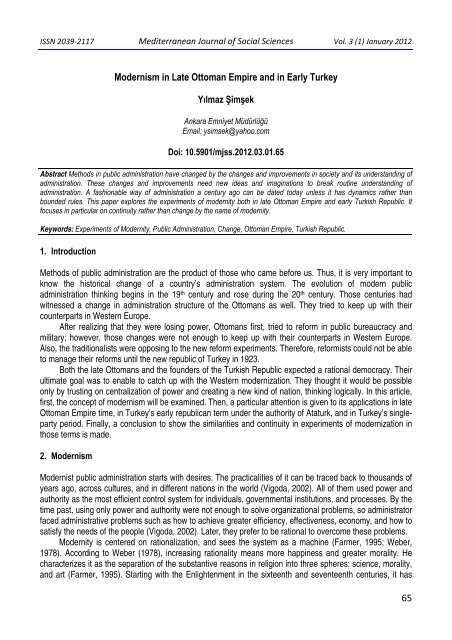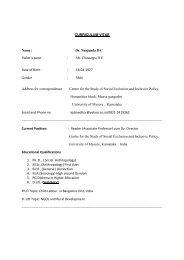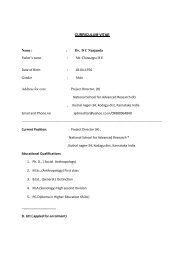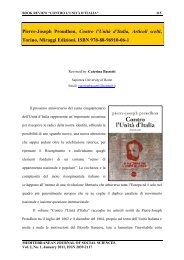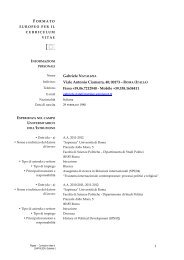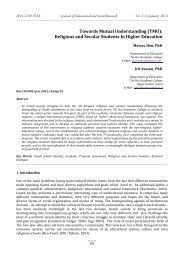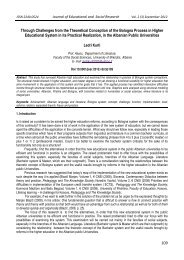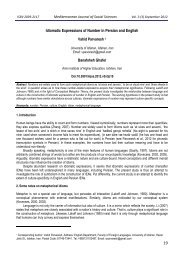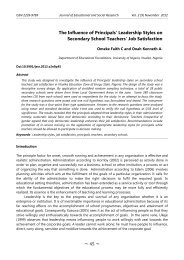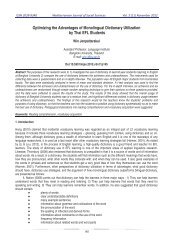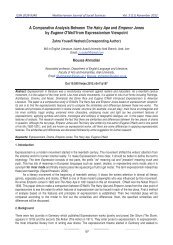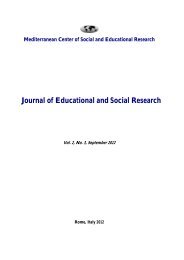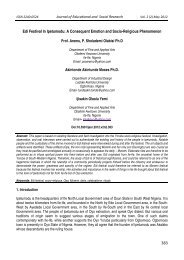65 Modernism in Late Ottoman Empire and in Early Turkey
65 Modernism in Late Ottoman Empire and in Early Turkey
65 Modernism in Late Ottoman Empire and in Early Turkey
You also want an ePaper? Increase the reach of your titles
YUMPU automatically turns print PDFs into web optimized ePapers that Google loves.
ISSN 2039‐2117 Mediterranean Journal of Social Sciences Vol. 3 (1) January 2012<br />
<strong>Modernism</strong> <strong>in</strong> <strong>Late</strong> <strong>Ottoman</strong> <strong>Empire</strong> <strong>and</strong> <strong>in</strong> <strong>Early</strong> <strong>Turkey</strong><br />
Yılmaz Şimşek<br />
Ankara Emniyet Müdürlüğü<br />
Email: ysimsek@yahoo.com<br />
Doi: 10.5901/mjss.2012.03.01.<strong>65</strong><br />
Abstract Methods <strong>in</strong> public adm<strong>in</strong>istration have changed by the changes <strong>and</strong> improvements <strong>in</strong> society <strong>and</strong> its underst<strong>and</strong><strong>in</strong>g of<br />
adm<strong>in</strong>istration. These changes <strong>and</strong> improvements need new ideas <strong>and</strong> imag<strong>in</strong>ations to break rout<strong>in</strong>e underst<strong>and</strong><strong>in</strong>g of<br />
adm<strong>in</strong>istration. A fashionable way of adm<strong>in</strong>istration a century ago can be dated today unless it has dynamics rather than<br />
bounded rules. This paper explores the experiments of modernity both <strong>in</strong> late <strong>Ottoman</strong> <strong>Empire</strong> <strong>and</strong> early Turkish Republic. It<br />
focuses <strong>in</strong> particular on cont<strong>in</strong>uity rather than change by the name of modernity.<br />
Keywords: Experiments of Modernity, Public Adm<strong>in</strong>istration, Change, <strong>Ottoman</strong> <strong>Empire</strong>, Turkish Republic.<br />
1. Introduction<br />
Methods of public adm<strong>in</strong>istration are the product of those who came before us. Thus, it is very important to<br />
know the historical change of a country’s adm<strong>in</strong>istration system. The evolution of modern public<br />
adm<strong>in</strong>istration th<strong>in</strong>k<strong>in</strong>g beg<strong>in</strong>s <strong>in</strong> the 19 th century <strong>and</strong> rose dur<strong>in</strong>g the 20 th century. Those centuries had<br />
witnessed a change <strong>in</strong> adm<strong>in</strong>istration structure of the <strong>Ottoman</strong>s as well. They tried to keep up with their<br />
counterparts <strong>in</strong> Western Europe.<br />
After realiz<strong>in</strong>g that they were los<strong>in</strong>g power, <strong>Ottoman</strong>s first, tried to reform <strong>in</strong> public bureaucracy <strong>and</strong><br />
military; however, those changes were not enough to keep up with their counterparts <strong>in</strong> Western Europe.<br />
Also, the traditionalists were oppos<strong>in</strong>g to the new reform experiments. Therefore, reformists could not be able<br />
to manage their reforms until the new republic of <strong>Turkey</strong> <strong>in</strong> 1923.<br />
Both the late <strong>Ottoman</strong>s <strong>and</strong> the founders of the Turkish Republic expected a rational democracy. Their<br />
ultimate goal was to enable to catch up with the Western modernization. They thought it would be possible<br />
only by trust<strong>in</strong>g on centralization of power <strong>and</strong> creat<strong>in</strong>g a new k<strong>in</strong>d of nation, th<strong>in</strong>k<strong>in</strong>g logically. In this article,<br />
first, the concept of modernism will be exam<strong>in</strong>ed. Then, a particular attention is given to its applications <strong>in</strong> late<br />
<strong>Ottoman</strong> <strong>Empire</strong> time, <strong>in</strong> <strong>Turkey</strong>’s early republican term under the authority of Ataturk, <strong>and</strong> <strong>in</strong> <strong>Turkey</strong>’s s<strong>in</strong>gleparty<br />
period. F<strong>in</strong>ally, a conclusion to show the similarities <strong>and</strong> cont<strong>in</strong>uity <strong>in</strong> experiments of modernization <strong>in</strong><br />
those terms is made.<br />
2. <strong>Modernism</strong><br />
Modernist public adm<strong>in</strong>istration starts with desires. The practicalities of it can be traced back to thous<strong>and</strong>s of<br />
years ago, across cultures, <strong>and</strong> <strong>in</strong> different nations <strong>in</strong> the world (Vigoda, 2002). All of them used power <strong>and</strong><br />
authority as the most efficient control system for <strong>in</strong>dividuals, governmental <strong>in</strong>stitutions, <strong>and</strong> processes. By the<br />
time past, us<strong>in</strong>g only power <strong>and</strong> authority were not enough to solve organizational problems, so adm<strong>in</strong>istrator<br />
faced adm<strong>in</strong>istrative problems such as how to achieve greater efficiency, effectiveness, economy, <strong>and</strong> how to<br />
satisfy the needs of the people (Vigoda, 2002). <strong>Late</strong>r, they prefer to be rational to overcome these problems.<br />
Modernity is centered on rationalization, <strong>and</strong> sees the system as a mach<strong>in</strong>e (Farmer, 1995; Weber,<br />
1978). Accord<strong>in</strong>g to Weber (1978), <strong>in</strong>creas<strong>in</strong>g rationality means more happ<strong>in</strong>ess <strong>and</strong> greater morality. He<br />
characterizes it as the separation of the substantive reasons <strong>in</strong> religion <strong>in</strong>to three spheres: science, morality,<br />
<strong>and</strong> art (Farmer, 1995). Start<strong>in</strong>g with the Enlightenment <strong>in</strong> the sixteenth <strong>and</strong> seventeenth centuries, it has<br />
<strong>65</strong>
ISSN 2039‐2117 Mediterranean Journal of Social Sciences Vol. 3 (1) January 2012<br />
constituted the lead<strong>in</strong>g m<strong>in</strong>d-set of the Western “assumptions <strong>and</strong> beliefs about the power <strong>and</strong> nature of the<br />
human subject <strong>and</strong> human reason” (Farmer, 1995, p.5). It underst<strong>and</strong>s the range of reason not to be limited,<br />
<strong>and</strong> refuses all traditional powers <strong>and</strong> conditions with the result of more freedom <strong>and</strong> opportunities (Farmer,<br />
1995).<br />
The basis of modernity, as they apply to management, are the dom<strong>in</strong>ation of means/end reason, the<br />
separation of facts <strong>and</strong> values, the use of the scientific method to solve public problems, the declaration of<br />
universal values, the belief <strong>in</strong> applicability of basic pr<strong>in</strong>ciples underly<strong>in</strong>g the social <strong>and</strong> political worlds, the<br />
faith <strong>in</strong> progress (John, 2004). For public adm<strong>in</strong>istration, these pr<strong>in</strong>ciples mean application of the pr<strong>in</strong>ciple of<br />
specialization, dom<strong>in</strong>ance of hierarchy <strong>in</strong> organizations, <strong>and</strong> emergence of large l<strong>in</strong>e bureaucracies which are<br />
the means of transform<strong>in</strong>g social action <strong>in</strong>to rationally organized action (John, 2004; Weber, 1978). As Max<br />
Weber (1978) mentioned, the development of bureaucracy is one of the important rationaliz<strong>in</strong>g mechanisms<br />
of society.<br />
In order to make organizations efficient, modernist public adm<strong>in</strong>istration gives importance on<br />
rationalism; therefore, it rises of the bureaucratic form of organization, <strong>and</strong> creates an adm<strong>in</strong>istrative<br />
technology. Weber (1978) divided it <strong>in</strong>to value-rationality, which is concerned with ends, <strong>and</strong> <strong>in</strong>strumentalrationality,<br />
which is concerned with means. For him (1958), the bureaucrat is one who occupies himself with<br />
the rational efficiency of means, not the question of ends. He identifies it with an <strong>in</strong>creas<strong>in</strong>g division of labor,<br />
bureaucracy <strong>and</strong> mechanization, <strong>and</strong> associates it with depersonalization, oppressive rout<strong>in</strong>e, ris<strong>in</strong>g<br />
secularism, as well as be<strong>in</strong>g destructive of <strong>in</strong>dividual freedom (Gerth <strong>and</strong> Mills, 1946).<br />
Modernization also requires adm<strong>in</strong>istrative efficiency. It is <strong>in</strong>dispensable for the progressive officials <strong>and</strong><br />
academics that created the modern discipl<strong>in</strong>e of public adm<strong>in</strong>istration. It is somewhat related with economics<br />
<strong>and</strong> economic systems (Farmer, 1995). Achiev<strong>in</strong>g greater efficiency through the elim<strong>in</strong>ation of overlap <strong>and</strong><br />
duplication of functions will greatly improve the operation of government agencies <strong>and</strong> <strong>in</strong>crease the<br />
legitimacy of government <strong>in</strong> the eyes of citizens (Simon, 1997).<br />
After the World War II, logical positivism was fashionable; thus, most of the modernists saw their charge<br />
to create a science based social technology that would enable prediction <strong>and</strong> control of human behavior. It<br />
was a desire to make organizations more effective. They believed the practice of adm<strong>in</strong>istration could more<br />
efficiently allocate the public's scarce resources (Gulick <strong>and</strong> Urwick, 1937). Accord<strong>in</strong>g to Taylor (1911) the<br />
best management depends on true science def<strong>in</strong>ed laws, rules, <strong>and</strong> pr<strong>in</strong>ciples. He argues scientific<br />
management enables both labor <strong>and</strong> management most productive as Weber talks of bureaucracy <strong>in</strong> relation<br />
to tradition. Taylor emphasis on time measurement <strong>and</strong> task analysis; however, he does not emphasis on the<br />
human factors with<strong>in</strong> the organizations. Accord<strong>in</strong>g to Simon (1997), adm<strong>in</strong>istrative pr<strong>in</strong>ciples such as "span of<br />
control", "centralization", "hierarchy", etc. were noth<strong>in</strong>g more than terms of art, filled with contradictions, <strong>and</strong><br />
of little use as guides to action. He seeks to accomplish goals of enhanc<strong>in</strong>g efficiency through improved<br />
approaches to adm<strong>in</strong>istrative decision mak<strong>in</strong>g.<br />
All adm<strong>in</strong>istrative scientists sought universalism for public adm<strong>in</strong>istration as a science (Farmer, 1995).<br />
For them, objective observation generates data about social behavior <strong>in</strong> order to make <strong>and</strong> test theories,<br />
laws, <strong>and</strong> generalizations (Simon, 1997). They all had trouble with identify<strong>in</strong>g a moral grip for core values<br />
because, at the core of this science was the need to separate facts from values (Farmer, 1995).<br />
Modernity has strong rules <strong>and</strong> regulations that restrict creativity <strong>and</strong> imag<strong>in</strong>ation. These restrictions,<br />
usually, can be seen as discipl<strong>in</strong>e, specialization <strong>and</strong> autonomy (Farmer, 1995). Henri Fayol (Gulick <strong>and</strong><br />
Urwick, 1937) describes fourteen pr<strong>in</strong>ciples of adm<strong>in</strong>istration; half of his pr<strong>in</strong>ciples are based on<br />
adm<strong>in</strong>istrative control, like authority, discipl<strong>in</strong>e, unity of comm<strong>and</strong> <strong>and</strong> adm<strong>in</strong>istration, centralization,<br />
hierarchy, order. An <strong>in</strong>creas<strong>in</strong>g anxiety about control <strong>and</strong> accountability of public adm<strong>in</strong>istration has led to<br />
more extensive <strong>and</strong> complex controls which have <strong>in</strong>creased bureaucratic distance between adm<strong>in</strong>istrators<br />
<strong>and</strong> the public they are expected to serve (Jones, 2000). In order to maximize consistency <strong>and</strong> control, harsh<br />
bureaucracy led to dehumanized relationships among personnel, <strong>and</strong> has negative results like “iron cage”<br />
expla<strong>in</strong>ed by Weber (1958).<br />
66
ISSN 2039‐2117 Mediterranean Journal of Social Sciences Vol. 3 (1) January 2012<br />
Critical theorists, like Habermas, view modernity as an unf<strong>in</strong>ished project, <strong>and</strong> postmodernists see it<br />
limited with particularism, scientism, technologism, enterprise, <strong>and</strong> hermeneutics (Farmer, 1995). In each five<br />
area modernist public adm<strong>in</strong>istration faces with paradoxes <strong>and</strong> bl<strong>in</strong>d spots that limit its capability for<br />
explanation <strong>and</strong> underst<strong>and</strong><strong>in</strong>g (Farmer, 1995). For example, decision mak<strong>in</strong>g <strong>in</strong> modernist public<br />
adm<strong>in</strong>istration is not aware of any good but efficiency. It may be useful to public adm<strong>in</strong>istrators to spot<br />
problems truly <strong>and</strong> to lay down effective solutions to those problems; however, real problem solv<strong>in</strong>g also<br />
raises questions of value --right <strong>and</strong> wrong. Therefore, ethic <strong>and</strong> morality ought to play an important role <strong>in</strong><br />
the conduct of the public's bus<strong>in</strong>ess.<br />
2.1. <strong>Modernism</strong> <strong>in</strong> <strong>Ottoman</strong> <strong>Empire</strong><br />
In the 15 th <strong>and</strong> 16 th centuries, the <strong>Ottoman</strong> <strong>Empire</strong> was one of greatest empires of the world, located from the<br />
Caucasus to the Balkans to North Africa. Start<strong>in</strong>g from the end of the 16 th century to the end of the 19 th<br />
century, it lost momentum slowly (Heper, 2000). Dur<strong>in</strong>g this term, the emperors showed signs of los<strong>in</strong>g their<br />
dom<strong>in</strong>ant position <strong>in</strong> the polity; whereas, religious <strong>in</strong>stitutions <strong>and</strong> the military ga<strong>in</strong>ed power <strong>in</strong> adm<strong>in</strong>istration<br />
(Heper, 2000).<br />
At the same time, the <strong>in</strong>tellectual, economic <strong>and</strong> technological transformations were tak<strong>in</strong>g place <strong>in</strong><br />
Europe, but the <strong>Ottoman</strong>s rema<strong>in</strong>ed oblivious to these developments. At the end of 18 th century, they realized<br />
that they were decl<strong>in</strong><strong>in</strong>g <strong>and</strong> los<strong>in</strong>g power. Because of this decl<strong>in</strong>e, they made great efforts to rega<strong>in</strong> the old<br />
governmental power <strong>and</strong> structure, but this strategy did not prevent them from los<strong>in</strong>g power.<br />
In order to change the <strong>Empire</strong>’s structure, they, first, tried to reform <strong>in</strong> public bureaucracy <strong>and</strong> military<br />
(Heper, 2000). They tried to change them as their counterparts <strong>in</strong> Western Europe. However, these reform<br />
experiments were faced opposition from the traditionalists, especially Islamists, so they were not able to ga<strong>in</strong><br />
control over the country until the new the Turkish Republic <strong>in</strong> 1923.<br />
The whole <strong>Ottoman</strong> political system was designed to elim<strong>in</strong>ate rivals to central power (Kongar, 1986).<br />
The warriors, who were opposed by eclectic popular culture, heterodox religious sects <strong>and</strong> threaten<strong>in</strong>g rival<br />
pr<strong>in</strong>cipalities were formed the state (Heper, 2000). Ma<strong>in</strong>ta<strong>in</strong><strong>in</strong>g law <strong>and</strong> order with<strong>in</strong> the country <strong>and</strong> keep<strong>in</strong>g<br />
the dom<strong>in</strong>ion together were the most critical concerns of the government (Heper, 2000). An <strong>Ottoman</strong><br />
statesman <strong>and</strong> historian, Tursun Beg, states that “harmony among men liv<strong>in</strong>g <strong>in</strong> society is achieved by<br />
statecraft” (Inalcik, 1964, p.42). This had been an <strong>Ottoman</strong> maxim s<strong>in</strong>ce the 15 th century. This maxim led the<br />
<strong>Ottoman</strong>s to concentrate power of the emperor; therefore, the <strong>Empire</strong>'s political organization was marked by<br />
personal rule of the emperor. Consequently, laws made by emperors were not considered permanent<br />
(Inalcik, 1964). Thus, adab tradition which “identified the state with established values, not with the reign<strong>in</strong>g<br />
ruler” was appeared (F<strong>in</strong>dley, 1980, p.9). For example, <strong>in</strong> the Decree of Alliance (Sened-i Ittifak) of 1808, “the<br />
state," not “the emperor,” was mentioned as a part to the pact between the central adm<strong>in</strong>istration <strong>and</strong> local<br />
notables (Inalcik, 1964). The <strong>Ottoman</strong>s could not completely separate the state from the emperor, but the<br />
state always constituted an important part of the <strong>Ottoman</strong> political culture because they believed that the<br />
happ<strong>in</strong>ess of the people depended on the well-be<strong>in</strong>g of the state (Heper, 2000).<br />
The <strong>Ottoman</strong> <strong>Empire</strong> was itself a European power <strong>in</strong> the cont<strong>in</strong>ent, <strong>and</strong> as early as the beg<strong>in</strong>n<strong>in</strong>g of the<br />
19 th century, the reformist emperors wanted to modernize it by adopt<strong>in</strong>g the Western, especially French,<br />
structures, behaviors <strong>and</strong> customs (Rouleau, 1993). Before 19 th century, sons of high officials were enjoyed<br />
a def<strong>in</strong>ite advantage over common people <strong>in</strong> terms of permission <strong>in</strong>to the system (Gerber, 1994). In order to<br />
change this underst<strong>and</strong><strong>in</strong>g <strong>and</strong> modernize the country, <strong>Ottoman</strong>s sent many people to Western Europe to<br />
learn their system. Thus, European educated civilian bureaucratic elite was appeared <strong>in</strong> later decades.<br />
In the early 19 th century, members of the other religions, Jews <strong>and</strong> Christians, were granted cultural<br />
rights <strong>and</strong> permitted to organize their own systems (Heper, 2000). By creat<strong>in</strong>g a department of the Chief Mufti<br />
religion was bureaucratized, <strong>and</strong> the religious Canon Law (Shari'a) <strong>and</strong> secular statues (orf-i sultani) were<br />
formulated (Aktay, 1993; Heper, 2000). Then, the moderniz<strong>in</strong>g emperor Sultan Mahmut II, together with the<br />
67
ISSN 2039‐2117 Mediterranean Journal of Social Sciences Vol. 3 (1) January 2012<br />
civilian bureaucratic elite, could push the members of the religious <strong>in</strong>stitution <strong>and</strong> abolish the rebellious<br />
Yeniceri (Janissary) Corps as a first step <strong>in</strong> which they projected to tra<strong>in</strong> "modern" officers for a "modern"<br />
army (Heper, 2000). After the reform<strong>in</strong>g the army with the Western model, the emperorship was started to be<br />
seen as a barrier to "modernization" by the new formed military elite educated <strong>in</strong> Western Europe. These new<br />
bureaucratic <strong>and</strong> military reforms enhanced the dichotomic social sets: executive elite, <strong>and</strong> the common<br />
people; however, the stability of <strong>Ottoman</strong> economic growth disallowed the rise of any more powerful class<br />
such as the bourgeoisie (Kongar, 1986).<br />
There had been a Western impact <strong>in</strong> the <strong>Empire</strong> with the Enlightenment. French Revolution, together<br />
with Enlightenment, became effective for the idea of the salvation of the state which was sought <strong>in</strong> the sphere<br />
of political thought (Kongar, 1986). By the 1839 (Tanzimat) reform, the announcement of civil rights to all the<br />
citizens regardless of race <strong>and</strong> religion, the moderniz<strong>in</strong>g high-level bureaucrats, who tra<strong>in</strong>ed <strong>in</strong> modern<br />
technocrat schools set up by emperor Abdulhamit II, resorted to personal rule which changed the way of<br />
underst<strong>and</strong><strong>in</strong>g bureaucracy, an amass<strong>in</strong>g wealth by abus<strong>in</strong>g or usurp<strong>in</strong>g state powers of the <strong>Empire</strong> (Heper,<br />
2000).<br />
The Tanzimat reform was not only a systematical legalization of the m<strong>in</strong>ority rights, but also a critical<br />
empowerment of the central bureaucracy (Kongar, 1986). Personal knowledge, predictability, meritocracy,<br />
<strong>and</strong> professionalization were exist <strong>and</strong> highly important (Gerber, 1994). Although the earlier center of the<br />
state was the emperor, the elite, who were educated <strong>in</strong> Western Europe, took over much of this role <strong>in</strong> the<br />
beg<strong>in</strong>n<strong>in</strong>g of the 19 th century. Elite became <strong>in</strong>creas<strong>in</strong>gly familiar with Western, especially French, culture<br />
while the people cont<strong>in</strong>ued with their traditional, Islamic customs <strong>and</strong> norms. Consequently, the cultural<br />
distance between normal citizens <strong>and</strong> the elite was <strong>in</strong>creased.<br />
At the end of the 19 th century, the elites undertook the task of sav<strong>in</strong>g the <strong>Empire</strong> (Kongar, 1986). The<br />
Young Turks neutralized the Old <strong>Ottoman</strong>s <strong>and</strong> <strong>in</strong>itiated the First Constitutional Period, which lasted from<br />
1876 to 1908 (Heper, 2000). They used “Young Turks” <strong>in</strong> their name to symbolize their nationalistic view<br />
because they believed nationalism lays <strong>in</strong> the basis of modernity. For them, congress was not a place for<br />
representation, but a place for elite discusses to fight of enlightened op<strong>in</strong>ions led to create the best policy<br />
(Lewis, 1961). They took positivist sociology to make public authority on social, religious, moral <strong>and</strong> political<br />
problems (Lewis, 1961).<br />
The decay of the <strong>Ottoman</strong> <strong>Empire</strong> was very fast <strong>in</strong> the 19 th century. Industry was hardly established,<br />
<strong>and</strong> there was not any ma<strong>in</strong> productive layer or civil society <strong>in</strong>consistent with the feudal system as<br />
bourgeoisie <strong>in</strong> Western states; therefore, the leadership of the first revolution <strong>in</strong> 1908 was composed of army<br />
officers called “Young Turks” --mostly journalists, mid-level bureaucrats, <strong>and</strong> military elites (Leicht, 1998).<br />
They governed <strong>Ottoman</strong> politics between 1912 <strong>and</strong> 1918 (Heper, 2000). They sought rationalism to be<br />
efficient <strong>in</strong> their control.<br />
Young Turks were mostly studied <strong>in</strong> Western Europe, <strong>and</strong> they become familiar with the regime exist<strong>in</strong>g<br />
there (Leicht, 1998). To legitimate their own elite look, they got the social eng<strong>in</strong>eer<strong>in</strong>g aspect of Auguste<br />
Comte's sociology which provided the knowledge for political authority; however, they still thought that the<br />
salvation of society depended on the welfare of the state (Heper, 2000). Aim<strong>in</strong>g a western-like country, they<br />
formed the Party of “Union <strong>and</strong> Progress,” <strong>and</strong> worked for bureaucratic reform (Kongar, 1986). After gett<strong>in</strong>g<br />
the government power <strong>in</strong> 1912, they entered the 1 st World War alongside the German <strong>Empire</strong>. At the end of<br />
the war, the <strong>Ottoman</strong> <strong>Empire</strong>, like Germany, was defeated by Brita<strong>in</strong>, France <strong>and</strong> Italy (Leicht, 1998). Then,<br />
the allied (British, French, <strong>and</strong> Italian) forces term<strong>in</strong>ated parliament <strong>and</strong> unseated the Young Turks; this<br />
caused the rise of Mustafa Kemal (C<strong>and</strong>ar <strong>and</strong> Pryce-Jones, 2000).<br />
The memory of the fall of the <strong>Ottoman</strong> <strong>Empire</strong> vitalized <strong>and</strong> enforced concern for national unity as a<br />
cont<strong>in</strong>uous emphasis on the need for be<strong>in</strong>g “one <strong>and</strong> together.” This over-emphasis on harmony was the<br />
ma<strong>in</strong> obstacle to the emergence of adversarial politics <strong>in</strong> early days of Turkish Republic; therefore, as <strong>in</strong> the<br />
<strong>Ottoman</strong> time, personal rules characterized politics dur<strong>in</strong>g the first years of the new republic (Heper, 2000).<br />
68
ISSN 2039‐2117 Mediterranean Journal of Social Sciences Vol. 3 (1) January 2012<br />
2.2. Ataturk Era<br />
Mustafa Kemal Ataturk, born <strong>in</strong> Selanik <strong>in</strong> 1881, served <strong>in</strong> Syria, Libya, <strong>and</strong> Bulgaria as a military officer <strong>in</strong><br />
the <strong>Ottoman</strong> army (Kazancigil <strong>and</strong> Ozbudun, 1981). When the 1 st World War ended, the armies of the allied<br />
forces, together with the Greeks, occupied nearly all parts of the <strong>Ottoman</strong> <strong>Empire</strong>. He did never give up, <strong>and</strong><br />
collected the leftovers of the <strong>Ottoman</strong> army. He <strong>and</strong> his friends wanted to establish a Republic as opposed to<br />
the <strong>Ottoman</strong> Monarchy, so they chose Ankara as headquarter for its central location. Then, they started the<br />
War of Independence <strong>and</strong> the seeds of a new country from there. The War of Independence took three years<br />
<strong>and</strong> by the end of 1922, all of the <strong>in</strong>vaders had left the country. In 1923, Mustafa Kemal was declared as the<br />
president of the new Turkish republic. The Emperor of the <strong>Ottoman</strong>s was allowed to cont<strong>in</strong>ue as Caliph<br />
(lieder) of the Muslims. <strong>Late</strong>r, he was sent <strong>in</strong>to exile to Paris <strong>and</strong> died there <strong>in</strong> 1944 (C<strong>and</strong>ar <strong>and</strong> Pryce-<br />
Jones, 2000). The new government was attracted to rationalism <strong>in</strong> its decision mak<strong>in</strong>g process to seek<br />
practical solutions for its problems on the basis of knowledge <strong>and</strong> experience.<br />
The philosophy beh<strong>in</strong>d Ataturk's reforms is now known as Kemalism. The heredity of the Kemalism can<br />
be traced back to the Young Turks’ the Union <strong>and</strong> Progress party; the declaration of the constitution, the<br />
nationalism, the emergence of secular organizations, <strong>and</strong> the creation of political parties were among the<br />
reforms of the Union <strong>and</strong> Progress (Kongar, 1986). Modernization, economic growth, <strong>and</strong> Westernization<br />
were the basic driv<strong>in</strong>g forces of “Kemalism” (Noel, 1995). It emphasizes a modern country, with its own<br />
national culture, open to the heritage of world civilization <strong>and</strong> modernization. It, first, appeared as the<br />
<strong>in</strong>troduction of the rights to the nation, <strong>and</strong> as the expression of the national sovereignty. It was a challenge<br />
to reach the level of modern civilization <strong>and</strong> an attempt to modernization. It requires experienc<strong>in</strong>g a modern<br />
social life, establish<strong>in</strong>g a secular state, <strong>and</strong> govern<strong>in</strong>g with a positive scientific mentality (Kazancigil <strong>and</strong><br />
Ozbudun, 1981).<br />
Kemalism got some motivations from both French <strong>and</strong> the Soviet models. From the French the concept<br />
of a centralized state, the secularist idea, <strong>and</strong> state nationalism rather than ethnic or religious identity, <strong>and</strong><br />
from the Soviets, it adopted a s<strong>in</strong>gle-party regulation, <strong>in</strong> its early time’s authoritarian structure <strong>and</strong> an etatist<br />
economic system (Rouleau, 1996). Ataturk, first, declared his basic pr<strong>in</strong>ciples [of Kemalism] as the pr<strong>in</strong>ciples<br />
of the <strong>Turkey</strong>’s first <strong>and</strong> s<strong>in</strong>gle-party, Republican Populist Party (RPP). Those six basic pr<strong>in</strong>ciples were<br />
written <strong>in</strong>to Article Two of the Constitution of the Turkish Republic <strong>in</strong> February 1937:<br />
1. Republicanism<br />
2. Nationalism<br />
3. Populism<br />
4. Etatism (Statism)<br />
5. Secularism<br />
6. Reformism (Revolutionism)<br />
Kemalism also has “secondary or complementary pr<strong>in</strong>ciples” which <strong>in</strong>cludes:<br />
1. National sovereignty<br />
2. National <strong>in</strong>dependence<br />
3. National unity <strong>and</strong> togetherness<br />
4. Peace at home peace abroad<br />
5. Modernization<br />
6. Scientificism <strong>and</strong> rationalism<br />
7. Humanitarianism<br />
Republicanism refers a political reform from the system of the <strong>Ottoman</strong> mult<strong>in</strong>ational monarchy to the nation<br />
state of <strong>Turkey</strong> (Akarsu, 1995). Kemalism believes that republican regime is the best to characterize the<br />
wishes of the people. The new Turkish republic was not only an adm<strong>in</strong>istrative replacement of <strong>Ottoman</strong><br />
69
ISSN 2039‐2117 Mediterranean Journal of Social Sciences Vol. 3 (1) January 2012<br />
<strong>Empire</strong>, but also an explicit new national identity which def<strong>in</strong>ed a new vision of nation through the nature of<br />
the state (Cooper, 2002).<br />
Nationalism is a pr<strong>in</strong>ciple which believes the Turkish state is an <strong>in</strong>separable one piece compris<strong>in</strong>g its<br />
l<strong>and</strong> <strong>and</strong> people. Also, it makes Turkish people not only citizens of the state but also members of the nation.<br />
As an umbrella, it covers elements of national consciousness, identity, <strong>and</strong> loyalty. The homogenous nation<br />
<strong>in</strong> Kemalism dedicated to modernity (Rouleau, 1996). It was not racist (Kazancigil <strong>and</strong> Ozbudun, 1981). As a<br />
modernist action, it is aga<strong>in</strong>st all traditional powers <strong>and</strong> imperialism. It also refuses the rule of any particular<br />
social class over Turkish society. It means to preserve the <strong>in</strong>dependence of the Turkish Republic, <strong>and</strong> to<br />
respect the right to <strong>in</strong>dependence of all other nations. It is based on ultimate value of Turkish citizenship as a<br />
k<strong>in</strong>d of realization of national identity of modern <strong>Turkey</strong> (Heper, 2000).<br />
Ataturk re<strong>in</strong>vented <strong>Turkey</strong> on the model of a nation-state. Creation of a new version of Turkish<br />
language, <strong>and</strong> rejection of the Muslim religion as a basis for government were placed a national entity<br />
(Cooper, 2002). Mustafa Kemal Ataturk did not just seek moderniz<strong>in</strong>g the Turkish nation; he, at the same<br />
time, had to make a nation out of the people who lived with<strong>in</strong> <strong>Turkey</strong>'s borders. A k<strong>in</strong>d of Turkish Anatolian<br />
nationalism was <strong>in</strong>vented. All who lived with<strong>in</strong> the borders of Turkish state were expected as Turks (Noel,<br />
1995).<br />
Populism is a policy <strong>in</strong> the <strong>in</strong>terests of the people <strong>and</strong> the denial of class contradictions (Kazancigil <strong>and</strong><br />
Ozbudun, 1981). It is aga<strong>in</strong>st class privileges <strong>and</strong> class dist<strong>in</strong>ctions <strong>and</strong> it recognized no <strong>in</strong>dividual, no family,<br />
no class <strong>and</strong> no organization as be<strong>in</strong>g above others. Ataturk stated that the true rulers of <strong>Turkey</strong> were the<br />
peasants (Akarsu, 1995). Populism also <strong>in</strong>cludes a revolutionary change <strong>in</strong> the status of women through the<br />
adoption of Western codes (i.e. the Swiss Civil Code) <strong>in</strong> <strong>Turkey</strong>.<br />
Ataturk stated that <strong>Turkey</strong>'s complete modernization was dependent on economic <strong>and</strong> technological<br />
developments (Kazancigil <strong>and</strong> Ozbudun, 1981). Etatism or statism can be <strong>in</strong>terpreted to mean that the state<br />
regulates the country's general economic activity, <strong>and</strong> engages <strong>in</strong> areas where private enterprises are not<br />
will<strong>in</strong>g to do (Akarsu, 1995). This pr<strong>in</strong>ciple was based on the needs of the new Turkish Republic because the<br />
number of entrepreneurs, <strong>in</strong> that time, was not adequate for national <strong>in</strong>terests. Therefore, statism was the<br />
necessity caused by the conditions.<br />
The <strong>Ottoman</strong> economy of the early n<strong>in</strong>eteen century was almost entirely agricultural. Ataturk, with his<br />
new Kemalist regime, sought to build up a modern <strong>in</strong>dustrial base under explicit state sponsorship (Cooper,<br />
2002). This sponsorship <strong>in</strong>cludes the direct government configuration of <strong>in</strong>dustries because of the lack of<br />
private entrepreneurs to accumulate sufficient capital to major <strong>in</strong>dustries <strong>and</strong> bus<strong>in</strong>esses just after the war<br />
years. Also, while formulat<strong>in</strong>g a five year plan for <strong>in</strong>dustrial development <strong>in</strong> 1933, the government of the new<br />
Turkish republic was <strong>in</strong>fluenced by developments <strong>in</strong> the Soviet Socialist Republicans Union (Cooper, 2002).<br />
In practice, production rose rapidly with that nationalist economic policy, <strong>and</strong> the heavy <strong>in</strong>dustry were<br />
established; these changes <strong>in</strong> the production created tremendous challenges to organization <strong>and</strong><br />
management that had not been confronted before (Cooper, 2002). New governmental factories caused flows<br />
from rural areas to cities.<br />
Secular citizenship tied to the Western Enlightenment (Rouleau, 1996). In <strong>Ottoman</strong> <strong>Empire</strong>, Islam<br />
dom<strong>in</strong>ated all areas of social, political, cultural <strong>and</strong> economic spheres of life, not only as a religion, but also<br />
as a way of liv<strong>in</strong>g. Mustafa Kemal Ataturk <strong>and</strong> his friends attacked religious dogmatism to start on a series of<br />
new socio-cultural reforms (Kongar, 1986). Kemalist secularism does not only mean separation of state <strong>and</strong><br />
religion, but also the respect for freedom of moral sense, worship <strong>and</strong> religion for every <strong>in</strong>dividual (Akarsu,<br />
1995). It <strong>in</strong>cludes the separation of religion from educational system, cultural life <strong>and</strong> legal affairs. It aims<br />
<strong>in</strong>dependence of thought <strong>and</strong> <strong>in</strong>dependence of <strong>in</strong>stitutions from the dom<strong>in</strong>ance of religion. Kemalist<br />
secularism is a rationalist <strong>and</strong> anti-clerical secularism; it did <strong>and</strong> does not advocate atheism, but aga<strong>in</strong>st any<br />
religion which was opposed to modernization (Kazancigil <strong>and</strong> Ozbudun, 1981).<br />
Reformism or revolutionism went beyond the recognition of the reforms which <strong>Turkey</strong> replaced<br />
traditional <strong>in</strong>stitutions with modern <strong>in</strong>stitutions. It means that traditional concepts can be elim<strong>in</strong>ated <strong>and</strong><br />
70
ISSN 2039‐2117 Mediterranean Journal of Social Sciences Vol. 3 (1) January 2012<br />
modern concepts can be adopted whenever they needed (Akarsu, 1995). It is not a static pr<strong>in</strong>ciple. It makes<br />
the pr<strong>in</strong>ciples of Kemalism alive all the time with the underst<strong>and</strong><strong>in</strong>g of dynamism. Dynamic changes,<br />
depend<strong>in</strong>g on the needs of the modern time, are <strong>in</strong> the core of it.<br />
Break<strong>in</strong>g with hundreds of years of <strong>Ottoman</strong> tradition, <strong>in</strong> his 15-16 years of leadership, Ataturk realized<br />
lots of political social, legal, economic <strong>and</strong> cultural reforms: the Sultanate (emperorship) was abolished <strong>in</strong><br />
1922; the Republic was declared <strong>in</strong> 1923; the Caliphship was abolished <strong>in</strong> 1924; the hat as opposed to fez<br />
was <strong>in</strong>troduced <strong>in</strong> 1925; the activities of religious sects were banned by law <strong>in</strong> 1925; Western calendar was<br />
<strong>in</strong>troduced <strong>in</strong> 1925; the modern secular system of jurisprudence was changed with old religious laws <strong>in</strong> 1926,<br />
with civil <strong>and</strong> penal codes borrowed, respectively, from Switzerl<strong>and</strong> <strong>and</strong> Italy; the Lat<strong>in</strong> alphabet was<br />
accepted <strong>in</strong> 1928; the Metric system was <strong>in</strong>troduced <strong>in</strong> 1931; the nicknames <strong>and</strong> personal titles were<br />
abolished <strong>in</strong> 1934; religious dress was prohibited <strong>in</strong> public <strong>in</strong> 1934; women received right to vote <strong>and</strong> be<br />
elected to parliament <strong>in</strong> 1934; <strong>and</strong> the surname law was <strong>in</strong>troduced <strong>in</strong> 1934 when Mustafa Kemal got his<br />
surname Ataturk, the father of Turks (Akarsu, 1995).<br />
Mustafa Kemal Ataturk changed <strong>Turkey</strong> <strong>in</strong>to a modern, dynamic European country. He replaced an<br />
absolute monarchy with a democratic republic, an Islamic culture with a firm secularism, adm<strong>in</strong>istrative<br />
system with an efficient centralized bureaucracy, a fractured agricultural economy with an <strong>in</strong>creas<strong>in</strong>gly urban<br />
<strong>and</strong> <strong>in</strong>dustrial society. No nation had ever founded a greater revolutionary zeal <strong>and</strong> undergone more<br />
sweep<strong>in</strong>g change than the Turkish Republic <strong>in</strong> such a short time. Mustafa Kemal’s methods could be<br />
somewhat cruel, but his aims were more benign; he wanted to change the state <strong>in</strong>to a Western-style country<br />
(Noel, 1995).<br />
In order to promote national unity, Mustafa Kemal encouraged a new national culture by cutt<strong>in</strong>g off from<br />
its religious <strong>Ottoman</strong> roots <strong>and</strong> impos<strong>in</strong>g the Turkish language with Lat<strong>in</strong>ized the old <strong>Ottoman</strong> alphabet based<br />
on Arab scripts (Rouleau, 1996). In <strong>Ottoman</strong> time, the paradoxical relation between the new <strong>and</strong> the old<br />
modes of life formed a deep dichotomisation of parts mentioned as religious bureaucracy <strong>and</strong> civil-military<br />
bureaucracy or secular elite <strong>and</strong> anti-secularist commoner (Aktay, 1993). Most of the power conflicts<br />
occurred, before the new Turkish republic, usually related to <strong>and</strong> expla<strong>in</strong>ed by that dichotomy (Aktay, 1993).<br />
The Unification of Education was the most efficient step <strong>in</strong> the process of creat<strong>in</strong>g a homogeneous society,<br />
<strong>and</strong> to remove that dual character of the Turkish <strong>in</strong>tellectual <strong>and</strong> political life <strong>in</strong> favor of the secularist or civilmilitary<br />
bureaucracy.<br />
For creat<strong>in</strong>g a nation state, all people had to be educated from s<strong>in</strong>gle ideological sources, as the unified<br />
educations, equally underst<strong>and</strong>able scriptures, or nationalism (Aktay, 1993). In the beg<strong>in</strong>n<strong>in</strong>g of 1920s, only<br />
20 percent of the Turkish population could read <strong>and</strong> write, <strong>and</strong> those who could read <strong>and</strong> write are mostly<br />
elite (Noel, 1995). Ataturk gave civil servants an ultimatum: master the Lat<strong>in</strong> characters or look for another<br />
job (Lawlor, 1996). Then, Qur’an was translated <strong>in</strong>to Turkish, <strong>and</strong> teach<strong>in</strong>g of Arabic had been banned by the<br />
reform<strong>in</strong>g fervor of Ataturk; thus, the only l<strong>in</strong>k with Islam was left (Aktay, 1993).<br />
Moreover, science was given importance very much <strong>in</strong> all areas of the life, <strong>in</strong>clud<strong>in</strong>g management.<br />
Mustafa Kemal’s words “the best <strong>and</strong> the real guide <strong>in</strong> life are knowledge <strong>and</strong> science,” which were carved on<br />
the walls of the Faculty of Language History <strong>and</strong> Geography <strong>in</strong> Ankara University, reflect this logical<br />
approach (Kongar, 1986). In an Izmir speech, on February 3, 1923, Ataturk stated "for a religion to be natural<br />
it must conform to reason, to science, to knowledge <strong>and</strong> logic…There is no clergy among us [Muslims]. We<br />
are all equal." (Reed, 1956, p. 299). Like a modernist public adm<strong>in</strong>istration theorist, he had great faith <strong>in</strong><br />
“scientific methods” <strong>in</strong> adm<strong>in</strong>istration; he considered that, as science, the westernization of his society<br />
throughout a positive approach would guarantee the universality of his reforms (Kongar, 1986).<br />
In addition to science, with the Kemalist reforms, Turkish Republic tended to rule with an <strong>in</strong>creas<strong>in</strong>gly<br />
centralized government. S<strong>in</strong>ce then, local governments have not been empowered to be more <strong>in</strong>dependent<br />
from the central government, <strong>and</strong> the mayors have been responsible to the governors who were appo<strong>in</strong>ted by<br />
the central government (Yuksel, 1999). Additionally, most of the government offices started to be managed<br />
71
ISSN 2039‐2117 Mediterranean Journal of Social Sciences Vol. 3 (1) January 2012<br />
by a central general office <strong>in</strong> Ankara. In Kemalist <strong>Turkey</strong>, modification through reform <strong>and</strong> centralization by an<br />
<strong>in</strong>terrelated midpo<strong>in</strong>t was the pr<strong>in</strong>ciple aim, as it had been <strong>in</strong> <strong>Ottoman</strong> <strong>Empire</strong> (Yuksel, 1999).<br />
<strong>Late</strong>r, the new Turkish Republic had two attempts for transition to multiparty regime of democracy until<br />
the third <strong>and</strong> last <strong>and</strong> rather permanent experience of the Democrat Party <strong>in</strong> 1945. The first two of them was<br />
realized when Ataturk was alive. The first one was tried <strong>in</strong> 1924 with (Terakkiperver Cumhuriyet Fırkası) the<br />
“Progressive Republican Party” (PRP) which is the most important alternative to the Republican Populist<br />
Party (RPP) (Kazancigil <strong>and</strong> Ozbudun, 1981). The members of the party were somewhat conservative, <strong>and</strong><br />
they declared that "the party is respectful to religious convictions <strong>and</strong> ideas" (Tunaya, 1991, p.158). At the<br />
same time, Sheikh Said was rebell<strong>in</strong>g by us<strong>in</strong>g religion. Follow<strong>in</strong>g the approval of the special law of “Law of<br />
Establish<strong>in</strong>g the Order,” PRP was closed rely<strong>in</strong>g on the decision of the executives that the party, or some<br />
members of the party, was exploit<strong>in</strong>g the religious feel<strong>in</strong>gs (Tunaya, 1991). In 1930, the second experience of<br />
multiparty democracy was realized with (Serbest Cumhuriyet Fırkası) the “Free Republican Party” (FRP).<br />
However, follow<strong>in</strong>g some of its policies, support<strong>in</strong>g some religious dem<strong>and</strong>s of the people, the government<br />
aga<strong>in</strong> closed the party <strong>and</strong> put an end to democratic life (Tunaya, 1991).<br />
After Ataturk died, Kemalism was evident that public adm<strong>in</strong>istration of RPP, as a s<strong>in</strong>gle-party<br />
government, wielded considerable power <strong>and</strong> <strong>in</strong>fluence <strong>in</strong> policy fram<strong>in</strong>g, policy mak<strong>in</strong>g, <strong>and</strong> policy<br />
implementation; therefore, it is subject to grow<strong>in</strong>g pressures of political players, social actors, managerial<br />
professionals, <strong>and</strong> the overall economic market (Vigoda, 2002).<br />
2.3. S<strong>in</strong>gle-Party Period<br />
When Ataturk died, <strong>in</strong> November 1938, Ismet Inonu, a close friend of Ataturk <strong>and</strong> the leader of the RPP, had<br />
become President. Despite Prime M<strong>in</strong>ister Ismet Inonu's efforts to bureaucratize the adm<strong>in</strong>istration, Ataturk,<br />
as a president, had ignored bureaucratic procedures <strong>and</strong> <strong>in</strong>sisted that the m<strong>in</strong>isters report directly to him<br />
(Atay, 1969). Similarly, President Inonu declared himself as the “National Chief” <strong>and</strong> the permanent chairman<br />
of the Republican Populist Party (RPP), <strong>and</strong> held the power of the state to safeguard Kemalist reforms<br />
(Heper, 2000; Kongar, 1986). He, as a prime m<strong>in</strong>ister from 1925 to 1937, president from 1938 to 1950 <strong>and</strong><br />
aga<strong>in</strong> prime m<strong>in</strong>ister from 1961 to 19<strong>65</strong>, believed <strong>in</strong> the strong state, remote from the societal groups, as <strong>in</strong><br />
the <strong>Ottoman</strong> state-oriented political viewpo<strong>in</strong>t, adab tradition (Heper, 2000).<br />
In fact, Ataturk knew that Turkish nation was not prepared to embrace modernity <strong>and</strong> revolve firmly to<br />
the West because of their strong l<strong>in</strong>ks to their past, so he enforced them over the protests of the old order.<br />
However, he did not aim to <strong>in</strong>sert Kemalism <strong>in</strong>to personal life as a system of public relations or ethical values<br />
(Noel, 1995). Conversely, RPP, as a s<strong>in</strong>gle party just after him, tried to <strong>in</strong>sert Kemalism <strong>in</strong>to private life as an<br />
<strong>in</strong>flexible <strong>and</strong> unchangeable policy of the new republic. This policy, <strong>in</strong> fact, is aga<strong>in</strong>st the faith of the dynamic<br />
pr<strong>in</strong>ciple of Kemalist reformism which accepts <strong>and</strong> requires changes with time rather than stability.<br />
S<strong>in</strong>ce his death the Turkish state has created a somewhat of cult figure of Ataturk (Leicht, 1998). It can<br />
be easily seen by a new one who visits <strong>Turkey</strong>. He would see an Ataturk portrait on the wall of the passenger<br />
cab<strong>in</strong> of the Turkish Airl<strong>in</strong>es, <strong>and</strong> <strong>in</strong> the city-center, he would possibly have to pass Ataturk Boulevard at<br />
some po<strong>in</strong>t. The cult adjo<strong>in</strong><strong>in</strong>g Ataturk is probably as tough as the cults that were <strong>in</strong> the Soviet Union (C<strong>and</strong>ar<br />
<strong>and</strong> Pryce-Jones, 2000). Every morn<strong>in</strong>g <strong>in</strong> school playgrounds, all the students state loudly <strong>and</strong> publicly their<br />
allegiance to Ataturk (Leicht, 1998). It is the creation of a narrow, authoritarian underst<strong>and</strong><strong>in</strong>g of his<br />
pr<strong>in</strong>ciples, dreams, <strong>and</strong> ideas by successors who altered Kemalism <strong>in</strong>to an <strong>in</strong>flexible policy <strong>and</strong> Mustafa<br />
Kemal Ataturk <strong>in</strong>to an untouchable public symbol (C<strong>and</strong>ar <strong>and</strong> Pryce-Jones, 2000).<br />
Although Kemalism, just after Ataturk, was considered an anti-religious ideology, it had noth<strong>in</strong>g aga<strong>in</strong>st<br />
the religion except to deny religion as a source of political power (Kongar, 1986). Ataturk, <strong>in</strong> fact, was a<br />
practic<strong>in</strong>g Muslim himself; his secularist project tried to achieve disconnection of religion from those areas of<br />
life of the modern Western state (Noel, 1995). However, unlike the secularism of the Anglo-Saxon tradition,<br />
with its emphasis on religious tolerance <strong>and</strong> pluralism, Turkish secularism, especially after Ataturk, carries<br />
72
ISSN 2039‐2117 Mediterranean Journal of Social Sciences Vol. 3 (1) January 2012<br />
overtones of irreligion; the advocates of this fundamental secularism th<strong>in</strong>k religion is contrary with pluralism<br />
<strong>and</strong> democracy (C<strong>and</strong>ar <strong>and</strong> Pryce-Jones, 2000). Therefore, so-called secularist elite <strong>in</strong> RPP, <strong>in</strong> the name of<br />
democracy, have made it harder for devout religious to get a proper education -- they saw secularism as an<br />
<strong>in</strong>flexible status has to stop women from wear<strong>in</strong>g what they want.<br />
Attack<strong>in</strong>g Islam as an obstacle to development was also <strong>in</strong> accordance with a firm belief <strong>in</strong> western<br />
positivism (Kongar, 1986). In fact, the positivist ideas came from the Young Turks, who absorbed such ideas<br />
directly from France. They thought that Islam presented a threat to modern <strong>Turkey</strong>, as the Catholic Church<br />
was to pose a threat to the French Republic (C<strong>and</strong>ar <strong>and</strong> Pryce-Jones, 2000). However, they did not imag<strong>in</strong>e<br />
that Islam did not have any <strong>in</strong>stitution that functions as a church, so their attempt to enforce secularism was<br />
altered <strong>in</strong>to an authoritarian movement aga<strong>in</strong>st persons (C<strong>and</strong>ar <strong>and</strong> Pryce-Jones, 2000). Consequently,<br />
secularism has become a radical political dichotomy that divides the s<strong>in</strong>gle-party members <strong>and</strong> the common<br />
people.<br />
Furthermore, the state elite, who followed Kemalism, m<strong>and</strong>ated a militantly secular, ethnically<br />
homogeneous republic prepared to jo<strong>in</strong> the modern world. They were even determ<strong>in</strong>ed to banish Islam from<br />
the public sphere to become a function<strong>in</strong>g nation-state (C<strong>and</strong>ar <strong>and</strong> Pryce-Jones, 2000). Dur<strong>in</strong>g the s<strong>in</strong>gle<br />
party period, Kemalism was affected by the traditional political culture <strong>and</strong> patrimonial <strong>in</strong>frastructure which<br />
allow the govern<strong>in</strong>g elite not tolerate criticism to their powers or policies (Yuksel, 1999).<br />
Like <strong>in</strong> the <strong>Ottoman</strong> <strong>Empire</strong>, the state elite <strong>in</strong> the RPP era was lost <strong>in</strong> thought with "high politics" rather<br />
than paid attention to socio-economic issues; Westernization, for example, governed the politics dur<strong>in</strong>g the<br />
s<strong>in</strong>gle-party period from 1923 to 1945 (Heper, 2000). In this period, adm<strong>in</strong>istration exercised considerable<br />
power <strong>and</strong> <strong>in</strong>fluence <strong>in</strong> policy fram<strong>in</strong>g, policy mak<strong>in</strong>g, <strong>and</strong> policy implementation, so it was subject matter to<br />
<strong>in</strong>creas<strong>in</strong>g pressures of political <strong>and</strong> social actors, adm<strong>in</strong>istrative professionals, <strong>and</strong> the general economic<br />
market (Vigoda, 2002).<br />
S<strong>in</strong>ce a multiparty regime <strong>in</strong> 1946, RPP shifted the guardianship of Kemalism with army, which is the<br />
firmest stronghold of Kemalism <strong>and</strong> the persistent guardian of the nationalism. Turkish military pressured the<br />
government to act <strong>in</strong> the boundary of Kemalism many times (C<strong>and</strong>ar <strong>and</strong> Pryce-Jones, 2000). However,<br />
<strong>Turkey</strong>'s laws do little to subord<strong>in</strong>ate the army to civilian control. Also, military officers, similar to the <strong>Ottoman</strong><br />
period <strong>and</strong> the s<strong>in</strong>gle-party years of the Republic, placed much more emphasis on the needs of the state as a<br />
whole, rather than on the needs of <strong>in</strong>dividual groups (Heper, 2000).<br />
Actually, soldiers were <strong>in</strong> central place <strong>in</strong> late <strong>Ottoman</strong> governmental policies, especially both <strong>in</strong> the<br />
second constitutional period (1908-1918), <strong>and</strong> <strong>in</strong> the war of <strong>in</strong>dependence (1918-1922). As a former soldier <strong>in</strong><br />
<strong>Ottoman</strong> army, Mustafa Kemal Ataturk also relied upon the military for his reforms, so the military has been<br />
an important political actor <strong>in</strong> <strong>Turkey</strong>, like <strong>in</strong> late <strong>Ottoman</strong> politics (Demirel, 2003). Unlike most armies <strong>in</strong><br />
democratic countries, Turkish army is held <strong>in</strong> high esteem. Rather than a professional job, it is a national duty<br />
of guardianship of the state <strong>and</strong> Kemalism which is the result of over-emphasis on power state. Therefore, it<br />
felt authorized to <strong>in</strong>tervene <strong>in</strong> civilian politics when they <strong>in</strong>terpreted civilian politics aga<strong>in</strong>st Kemalisim. After<br />
switch<strong>in</strong>g to the multiparty regime, between 1960 <strong>and</strong> 1980, it overthrew the governments three times by the<br />
sake of protect<strong>in</strong>g Kemalism (Demirel, 2003). In 1983, the military generals, however, voluntarily restored<br />
civilian rul<strong>in</strong>g, <strong>and</strong> a newly selected government took office (C<strong>and</strong>ar <strong>and</strong> Pryce-Jones, 2000).<br />
3. Conclusion<br />
S<strong>in</strong>ce the late <strong>Ottoman</strong> period, Turks tried to reach modernism by imitat<strong>in</strong>g Western reforms <strong>and</strong> policies.<br />
This pursuit cont<strong>in</strong>ued for more than a hundred year without a complete success, but there was always a<br />
faith <strong>in</strong> progress. For the sake of modernization, they tried rationalization, specialization <strong>in</strong> bureaucracy, <strong>and</strong><br />
scientific methods for universal values. <strong>Late</strong>r, they refused all traditional powers <strong>and</strong> tried to catch modernity<br />
by a central nation-state. They realized lots of reforms, but, as shown above, there had been a hidden<br />
cont<strong>in</strong>uity rather than change s<strong>in</strong>ce the beg<strong>in</strong>n<strong>in</strong>g of the modernization of <strong>Turkey</strong>.<br />
73
ISSN 2039‐2117 Mediterranean Journal of Social Sciences Vol. 3 (1) January 2012<br />
Kemalist cultural modernization of <strong>Turkey</strong>, affect<strong>in</strong>g education, political life, communications, religion,<br />
women's rights, <strong>and</strong> even the acceptable style of headwear, is the furthermost case <strong>in</strong> modern history of a<br />
whole nation be<strong>in</strong>g reformed by a person <strong>and</strong> of that reform<strong>in</strong>g be<strong>in</strong>g accepted by most of the population.<br />
The spirit of it was the liberty <strong>and</strong> unity of the nation <strong>and</strong> country, the creation of a society without classes<br />
<strong>and</strong> privileges, secularism <strong>and</strong> republican approach, <strong>and</strong> reformism by the needs of modernization. However,<br />
<strong>in</strong> the h<strong>and</strong>s of the Kemalist elite, pr<strong>in</strong>ciples of Kemalism hardened <strong>in</strong>to a firm accepted view that became a<br />
barrier to promote democratic <strong>and</strong> economic growth <strong>in</strong> a chang<strong>in</strong>g globe.<br />
Unlike traditional underst<strong>and</strong><strong>in</strong>g, modernity is a cont<strong>in</strong>u<strong>in</strong>g subject <strong>and</strong> needs changes day by day.<br />
Yesterday's modernity cannot be modernity today; however, s<strong>in</strong>gle-party <strong>in</strong>terpretation of modernism is very<br />
static <strong>and</strong> bounded by strong rules. Whoever imag<strong>in</strong>ed out of those limits was seen aga<strong>in</strong>st Kemalism. Those<br />
established bounds were not different than the experiments of the <strong>Ottoman</strong> modernism. Actually, reformism,<br />
as a dynamic pr<strong>in</strong>ciple of Kemalism, might change that cont<strong>in</strong>uity, but strict regulations, which restricted<br />
creativity <strong>and</strong> imag<strong>in</strong>ation, was the ma<strong>in</strong> obstacle for that change.<br />
First, the confidence on strong central power at the end of the <strong>Ottoman</strong> <strong>Empire</strong> was not change <strong>in</strong> new<br />
Turkish Republic (Yuksel, 1999). This caused a real dom<strong>in</strong>ance of hierarchy <strong>and</strong> autonomy which was the<br />
ma<strong>in</strong> reason of [bureaucratic] distance between adm<strong>in</strong>istrators <strong>and</strong> the public. This made the Turkish<br />
modernization experiment, under the authoritarian regime of Ataturk, same as the late <strong>Ottoman</strong><br />
modernization, which also dependent on dictatorial autonomy of Young Turks.<br />
Secondly, the dichotomic structure of the nation did not change. There was always dichotomisation of<br />
parts mentioned as civil-military elite <strong>and</strong> traditional-religious people. Sometimes, it was seen as s<strong>in</strong>gle-party<br />
members or bureaucrats <strong>and</strong> common people. Therefore, it is easy to say that the <strong>Ottoman</strong> heritage of us<strong>in</strong>g<br />
bureaucracy to usurp state powers also dom<strong>in</strong>ated Turkish political traditions <strong>and</strong> practice (Heper, 2000).<br />
This is an important po<strong>in</strong>t to show the cont<strong>in</strong>uity rather than change.<br />
Another example of cont<strong>in</strong>uity can be seen <strong>in</strong> over-emphasiz<strong>in</strong>g on rational logic <strong>and</strong> science. Both the<br />
late <strong>Ottoman</strong>s <strong>and</strong> early Republicans looked for universal values for their reforms. To be efficient <strong>in</strong> their<br />
adm<strong>in</strong>istrative process was so important that they chose to be rational on their adm<strong>in</strong>istrative decisions.<br />
Primarily, Young Turks at the end of <strong>Ottoman</strong> period tried to create a science based social technology to<br />
provide the knowledge for political authority. Their French based positivist ideas also affected new<br />
Republicans <strong>in</strong> their adm<strong>in</strong>istrative reforms. They based on science to guarantee the universality of their<br />
reforms.<br />
Through the late <strong>Ottoman</strong> <strong>Empire</strong> <strong>and</strong> new Turkish Republic, nationalism addressed the theme of<br />
culture <strong>and</strong> identity. As a modernist course of action, it operated most of developments <strong>in</strong> the form of a<br />
nation-state <strong>in</strong> <strong>Turkey</strong>. It was used by the elite as a driv<strong>in</strong>g motive for social mobility to govern the masses.<br />
However, <strong>in</strong> both terms, they never gave up the idea of power state. In the republican era, the belief <strong>in</strong> strong<br />
state reached its maxim which required a strong connection between the state <strong>and</strong> the adm<strong>in</strong>istrator;<br />
therefore, as <strong>in</strong> <strong>Ottoman</strong> <strong>Empire</strong>, salvation of society depended on the <strong>in</strong>terests of the state. As the result of<br />
the concept of power state, not only <strong>in</strong> <strong>Ottoman</strong> <strong>Empire</strong>, but also <strong>in</strong> early Turkish republic, army had a<br />
mission of guardianship of the state <strong>in</strong>terests.<br />
As a result of modernity, the shift to popular sovereignty <strong>and</strong> representative government became<br />
possible only when elected officials learned how to appo<strong>in</strong>t <strong>and</strong> control public officials charged with the<br />
implementation of public policies. However, <strong>in</strong> any regime dom<strong>in</strong>ated by appo<strong>in</strong>ted officials it may be<br />
assumed that lazy <strong>and</strong> greedy bureaucrats will abuse their powers <strong>and</strong> bad public adm<strong>in</strong>istration will result. In<br />
order to complete transformation <strong>in</strong>to a fully modernity, imag<strong>in</strong>ation <strong>and</strong> creativity should not be bounded by<br />
strict rules, <strong>and</strong> all ideas need to be respected equal-democratic <strong>and</strong> secular.<br />
74
ISSN 2039‐2117 Mediterranean Journal of Social Sciences Vol. 3 (1) January 2012<br />
References<br />
Akarsu, B., 1995. Ataturk Devrimi ve Temelleri. Ankara: Inkilap Kitapevi.<br />
Atay, F. R., 1969. Cankaya: Ataturk'un Dogumundan Olumune Kadar. Istanbul: Dogan Kardes.<br />
Aktay, Y., 1993. Political <strong>and</strong> Intellectual Disputes on the Academisation of Religious Knowledge, [onl<strong>in</strong>e]<br />
[Accessed 01 April 2009].<br />
C<strong>and</strong>ar, C. & Pryce-Jones, D., 2000, Autumn. Ataturk's Ambiguous Legacy. Wilson Quarterly, 24, 4. Available through: EBSCOhost<br />
database [Accessed 02 May 2008].<br />
Cooper, M., 2002. The legacy of Atatürk: Turkish political structures <strong>and</strong> policy-mak<strong>in</strong>g. International Affairs, 78, 115-128.<br />
Demirel, T., 2003. The Turkish Military's Decision to Intervene: 12 September 1980. Armed Forces & Society, 29, 2. Available through:<br />
EBSCOhost database [Accessed 11 April 2009].<br />
Farmer, D. J., 1995. Language of Public Adm<strong>in</strong>istration: Bureaucracy, Modernity <strong>and</strong> Postmodernity. Tuscaloosa: University of Alabama<br />
Press.<br />
F<strong>in</strong>dley, C., 1980. The Bureaucratic Reform <strong>in</strong> the <strong>Ottoman</strong> <strong>Empire</strong>: The Sublime Porte, 1789-1922. Pr<strong>in</strong>ceton: Pr<strong>in</strong>ceton University<br />
Press.<br />
Gerth, H. & Mills, C.W., 1946. From Max Weber: Essays <strong>in</strong> Sociology. New York: Galaxy Books.<br />
Gerber, H., 1994. State, Society, <strong>and</strong> Law <strong>in</strong> Islam: <strong>Ottoman</strong> Law <strong>in</strong> Comparative Perspective. New York: Albany State University Press.<br />
Gulick, L. & Urwick L., 1937. Papers on the Science of Adm<strong>in</strong>istration. New York: Institute of Public Adm<strong>in</strong>istration.<br />
Heper, M., 2000, Fall. The <strong>Ottoman</strong> Legacy <strong>and</strong> Turkish Politics. Journal of International Affairs, 54, 1. Available through: EBSCOhost<br />
database [Accessed 02 May 2009].<br />
Inalcik, H., 1964. The Nature of Traditional Society. In R.E. Ward, D.A. Rustow (ed.), Political Modernization <strong>in</strong> Japan <strong>and</strong> <strong>Turkey</strong> (pp.<br />
42-63). Pr<strong>in</strong>ceton: Pr<strong>in</strong>ceton University Press.<br />
John, P., 2004. Public Management, [onl<strong>in</strong>e] [Accessed 02 May 2009].<br />
Kazancigil , A. & Ozbudun, E., 1981. Ataturk, Founder of a Modern State. London: C. Hurst.<br />
Kongar, E., 1986. <strong>Turkey</strong>'s Cultural Transformation. In G. Renda, C. M. Kortepeter (ed.), The Transformation of Turkish Culture, The<br />
Ataturk Legacy (pp. 19-68). Pr<strong>in</strong>ceton, New Jersey: The K<strong>in</strong>gston Press. Inc.<br />
Lawlor, E., 1996, March. His name meant "Father Turk," <strong>and</strong> that he was. Smithsonian, 26, 116-127.<br />
Leicht, J., 1998. A balance sheet of Kemalism, [onl<strong>in</strong>e] [Accessed 11 April<br />
2009].<br />
Lewis, B., 1961. The Emergence of Modern <strong>Turkey</strong>. London: Oxford University Press.<br />
Weber, M., 1958. The Protestant Ethic <strong>and</strong> the Spirit of Capitalism. New York: Charles Scribner.<br />
Weber, M., 1978. Economy <strong>and</strong> Society: An Outl<strong>in</strong>e of Interpretive Sociology. In G. Roth, C. Wittich (ed.), (pp. 24-25). Berkeley:<br />
University of California Press.<br />
Noel, M., 6/12/1995. West from <strong>Turkey</strong>. National Review, 47, 11.<br />
Reed, H. A., 1956. Revival of Islam <strong>in</strong> Secular <strong>Turkey</strong>. The Middle East Journal, 8, 267-282.<br />
Rouleau, E., 1996, Summer. <strong>Turkey</strong>: Beyond Ataturk. Foreign Policy Issue, 103, 70-82. Available through: EBSCOhost database<br />
[Accessed 02 May 2009].<br />
Rouleau, E., 1993, Nov/Dec. The Challenges to <strong>Turkey</strong>. Foreign Affairs, 72, 5. Available through: EBSCOhost database [Accessed 02<br />
May 2009].<br />
Simon, H. A., 1997. Adm<strong>in</strong>istrative Behavior. NY:The Free Press.<br />
Taylor, F. W., 1911. The Pr<strong>in</strong>ciples of Scientific Management. London, UK: Harper & Brothers.<br />
Tunaya, Tarik Z., 1991. Islamcılık Akımı. Istanbul: Simavi Yay<strong>in</strong>lari.<br />
Vigoda, E., 2002. Reth<strong>in</strong>k<strong>in</strong>g the identity of public adm<strong>in</strong>istration: Interdiscipl<strong>in</strong>ary reflections <strong>and</strong> thoughts on managerial reconstruction,<br />
[onl<strong>in</strong>e] [Accessed 12 April 2009].<br />
Yuksel, E., 1999. Cannibal Democracies, Theocratic Secularism: The Turkish Version, [onl<strong>in</strong>e] <br />
[Accessed 12 April 2009].<br />
75


